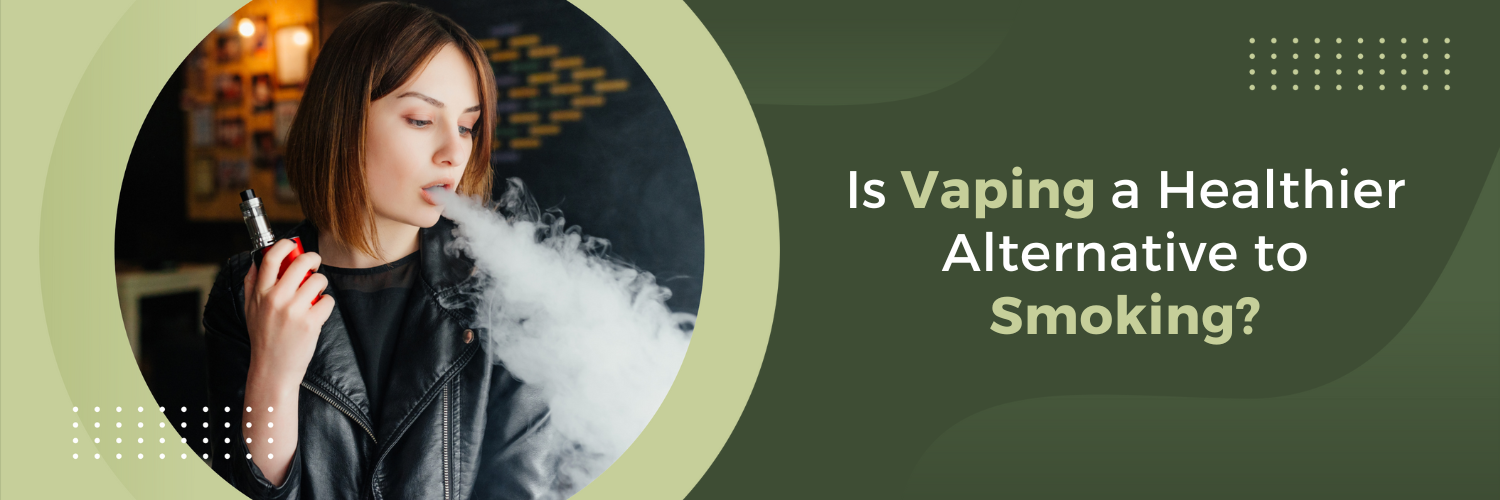Vaping vs Smoking
Vaping is a process that operates differently from smoking. Vaping devices are powered by batteries and consist of a heating element, a cartridge or tank to hold the e-liquid, and an atomizer to convert the liquid into aerosol. E-liquids usually contain propylene glycol, vegetable glycerin, flavorings, and nicotine. The user inhales this aerosol, commonly referred to as vapor.
On the other hand, smoking involves burning tobacco, which releases thousands of harmful chemicals, including nicotine, tar, carbon monoxide, and various carcinogens. These substances are known to be detrimental to health and are responsible for the numerous adverse effects associated with smoking, such as lung diseases, heart problems, and an increased risk of cancer.
The Potential Health Benefits of Vaping
Vaping has been proposed as a potential healthier alternative to smoking traditional tobacco products. While it is not completely risk-free, several studies and research suggest that vaping may have some health benefits when compared to smoking. Here are some of the potential health benefits of vaping:
- Elimination of Tobacco Combustion: One of the significant advantages of vaping over smoking is that it eliminates the process of tobacco combustion. When tobacco is burned in cigarettes, it releases a multitude of harmful chemicals and toxins, many of which are known carcinogens. In contrast, vaping devices heat e-liquids to produce aerosol, which does not involve burning and, therefore, reduces the exposure to harmful substances produced by combustion.
- Reduced Exposure to Harmful Chemicals: While e-liquids used in vaping may contain nicotine, they do not contain many of the harmful chemicals found in tobacco smoke, such as tar, carbon monoxide, and arsenic. By avoiding these harmful substances, vaping may reduce the risk of certain smoking-related health issues, such as lung diseases, cardiovascular problems, and respiratory ailments.
- Potentially Lower Risk of Cancer: Smoking is a well-established risk factor for various types of cancer, including lung, throat, mouth, and esophageal cancer. Since vaping does not involve the combustion of tobacco, it may have a lower cancer risk profile compared to smoking. However, it is essential to emphasize that vaping is not entirely risk-free and may still pose some cancer risks due to other constituents present in e-liquids.
- Potential Smoking Cessation Tool: Vaping has shown promise as a smoking cessation aid for some individuals. For those struggling to quit smoking, vaping can offer a way to reduce nicotine dependence while providing a similar sensory experience to smoking. Some smokers have successfully used vaping as a stepping stone to quit smoking entirely, eventually transitioning to lower nicotine strengths and even stopping vaping altogether.
- Lesser Impact on Secondhand Smoke: Secondhand smoke from traditional cigarettes is harmful to non-smokers and has been linked to various health issues, especially for those frequently exposed to it. Vaping, on the other hand, produces aerosol that dissipates more quickly and generally contains fewer harmful chemicals than tobacco smoke. This characteristic makes vaping a potentially less harmful option for those in the vicinity of vapers.
The Risks and Side Effects of Vaping
While vaping is often marketed as a potentially healthier alternative to smoking, it is not without risks and side effects. As with any activity involving inhaling substances into the lungs, there are concerns associated with vaping. Here are some of the risks and side effects of vaping:
- Respiratory Issues: Vaping can cause various respiratory problems, especially when the aerosol is inhaled. Some users may experience symptoms such as coughing, wheezing, shortness of breath, and chest tightness. These effects can be particularly concerning for individuals with pre-existing respiratory conditions, such as asthma or chronic obstructive pulmonary disease (COPD).
- Lung Irritation: The inhalation of aerosolized e-liquids can irritate the lungs and airways. This irritation may lead to inflammation and can be more pronounced in individuals with sensitive respiratory systems. The long-term consequences of chronic lung irritation from vaping are not yet fully understood.
- Nicotine Addiction: Many e-liquids used in vaping contain nicotine, which is a highly addictive substance. Nicotine addiction can develop rapidly, and individuals who were not previously addicted to nicotine, such as non-smokers and young people, may become dependent on vaping. Nicotine addiction poses its own health risks, including increased heart rate, blood pressure, and potential adverse effects on brain development in adolescents.
- Potential Cardiovascular Effects: Vaping has been associated with temporary changes in cardiovascular function, such as increased heart rate and blood pressure. While these effects are generally milder than those caused by smoking, they can still be concerning, especially for individuals with existing cardiovascular conditions.
- Chemical Exposure: Although e-liquids typically contain fewer harmful chemicals than traditional tobacco products, they may still expose users to certain chemicals, such as diacetyl and acetyl propionyl, which have been linked to lung diseases, including the development of “popcorn lung” (bronchiolitis obliterans).
Vaping and Smoking Regulations
The regulation of vaping and smoking varies significantly across different regions and countries. Some countries have implemented strict regulations on vaping products, including age restrictions, product quality standards, and restrictions on marketing and advertising. Others have more lenient or no specific regulations in place.
One particular concern in the regulatory landscape is the marketing of vaping products and whether they target younger audiences. Some critics argue that certain flavors and advertising tactics appeal to adolescents, potentially leading to an increase in youth vaping.
Public health organizations play a crucial role in shaping vaping and smoking regulations. These organizations assess scientific evidence and advocate for policies that protect public health while recognizing harm reduction strategies for smokers seeking alternatives.
Making an Informed Choice
When considering whether to engage in vaping or any other activity that may have potential health implications, making an informed choice is of paramount importance. Whether you are a smoker seeking a potential alternative or someone contemplating trying vaping for other reasons, here are some key points to consider in making an informed decision:
Learn About Vaping: Before trying vaping, understand how it works and what’s in e-liquids. Get to know the different types of vaping devices and their potential health effects.
Know the Risks and Benefits: Consider both the risks and benefits of vaping compared to smoking. Understand that vaping isn’t risk-free and decide if it’s right for you.
Get Professional Advice: If you’re a smoker wanting to quit, talk to healthcare professionals. They can recommend the best ways to quit, including vaping, based on your health.
Think About Nicotine Dependence: If you’re addicted to nicotine, vaping might help you cut back or quit. But if you don’t smoke or aren’t addicted, think carefully before starting vaping.
Choose Safe Products: If you decide to vape, pick products from trusted brands that disclose ingredients and follow quality standards. Avoid cheap or counterfeit products.
Explore Other Options: If you’re quitting smoking, consider other methods like nicotine replacement therapy or counseling.
Stay Informed: Keep up with the latest vaping research to make informed decisions about your health.
Be Wary of Marketing: Be skeptical of vaping ads targeting young people. Avoid products that seem to appeal to non-smokers or minors.
Follow Regulations: Follow local laws about vaping and smoking, including age restrictions.
Monitor Your Health: Pay attention to how vaping affects your health. If you have any problems, stop vaping and see a doctor.
Choose Leaf Alleviate for Your CBD Needs
If you are considering making a switch to vaping or using it as a smoking cessation aid, we urge you to carefully weigh the available evidence and seek professional advice. To explore and learn more about the products offered by Leaf Alleviate, we encourage you to visit our shop and stay informed on the latest updates. Your health matters, and being proactive about understanding the risks involved can lead to more responsible choices for a healthier future.
FAQs
Q: Is vaping completely safe for my health?
No, vaping is not completely safe; it carries risks and can cause respiratory issues.
Q: Can vaping help me quit smoking?
Vaping can be used as a smoking cessation method, but seeking professional guidance is important.
Q: Are there any age restrictions for purchasing vaping products?
Yes, there are age restrictions in many regions, typically 18 or 21 years old.
Q: What are the most common misconceptions about vaping?
Misconceptions include thinking vaping is entirely harmless and that all e-liquids are the same.
Q: How does vaping compare to other smoking cessation methods?
Vaping is one of several methods available, and effectiveness varies from person to person. Professional advice is recommended for finding the best approach.












